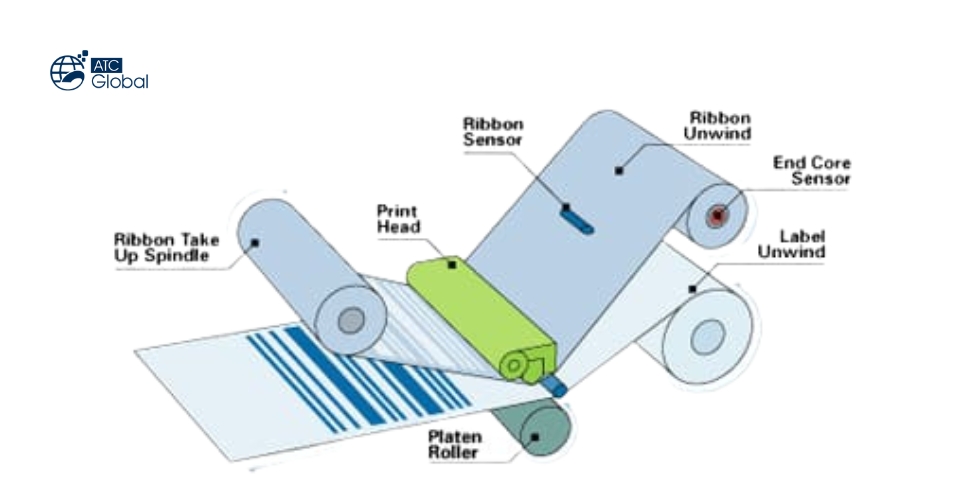Thermal Printer: What is It and How Does It Work? Leave a comment
Thermal printers make it easy to print labels, receipts, and bar codes quickly and affordably in one area or on the go. In this post, we’ll go over everything you need to know about thermal printers and the main characteristics to look for so you can choose the best model for your business.
What is a Thermal Printer?
A thermal printer is a kind of printer that prints black text or images by pressing a heated thermal printhead against a medium.
Depending on the type of thermal printer, the heated printhead either transfers solid ink from a ribbon and adheres it to the medium, or it activates special chemically treated paper, known as thermal paper. They are widely employed in a wide range of sectors for the production of labels, receipts, barcodes, ID badges, and many other purposes.
How Does a Thermal Printer Work?
The two types of thermal printing techniques—thermal transfer printing and direct thermal printing—must be understood before you can comprehend how a thermal printer operates.
Direct Thermal Printing
Direct thermal printing does not require ribbons, ink, or toner. Rather, heat-sensitive thermal paper is immediately heated and compressed by the printer. When the printhead’s heat reaches the thermal paper, it reacts by turning black and creating an image or text.
Since direct thermal printers don’t require ink or toner, their maintenance expenses are minimal when compared to other printer kinds. But, as was already said, one disadvantage of thermal paper is that it might fade over time, especially when exposed to heat and light.
Due to the fact that they were printed on thermal paper, you could notice that your old receipts fade with time. Furthermore, because the printing material itself controls the color, you can only print in one color at a time with this kind of thermal printer.
Thermal Transfer Printing
In contrast to direct thermal printing, which prints directly onto the surface of the medium, thermal transfer printers use a printhead that presses an ink ribbon (or ribbons) coated in wax onto the medium. The ink is exposed as the wax melts, where it is then transferred and allowed to dry on the printing substrate.
If your printer has numerous ribbons, you can print in various colors simultaneously, and prints are less likely to fade over time than with a direct thermal printer. This is the main advantage of this type of thermal printer over the latter.
That being stated, long-term maintenance expenses may increase due to the introduction of the ribbon, which needs to be changed. These printers are still dependable and sturdy, but they could be a little more prone to malfunctions due to their increased number of moving components.
What Are Thermal Printers Used for?
Thermal printers are widely utilized in a variety of applications due to their energy efficiency, speed, and portability. Here are a few of the many applications across several industries:
- Transportation and logistics: receiving, packing slips, inventory control, shipment, and return labels
- Manufacturing: tracking of progress, quality assurance, maintenance or parts management labeling
- Healthcare: lab or pharmacy sample labels, patient identifying wristbands, and asset management
- Sales and hospitality: price tags, receipts from point of sale or mobile point of sale, visitor passes or cards, identity badges, inventory control
- Government: ID badges, emergency preparedness, supply chain labeling, and system administration
Benefits of Using a Thermal Label Printer
Here are some reasons why you should consider adopting thermal label printers.
1) Thermal printers are quick and efficient.
Thermal printers do not have to wait for the ink to dry, so they can print labels more faster than inkjet printers, making them perfect for busy firms that want a large number of labels in a short period of time.
2) Thermal printers are more durable.
Thermal printers do not have moving elements that might be damaged, making them more durable than inkjet printers. They are ideal for printing labels in tough locations or when the printer needs to be transported regularly.
3) Thermal printers do not require ink.
Thermal printers use heat to transfer images onto labels, so they don’t need ink cartridges, making them less expensive to operate in the long term and helping businesses save money on printing expenditures.
Since they generate less waste from empty ink cartridges, thermal printers are also more environmentally friendly.
4. Thermal printers are multifunctional.
Thermal printers may print on a variety of materials, including paper, plastic, nylon, polyester, vinyl, and composite materials. For businesses who need to print labels for products that might be exposed to sunlight or other elements that could cause the label to fade, these printers are perfect.
Thermal printers are also more versatile since they can print in a wide range of colors, including black, white, silver, and gold, making them ideal for printing labels with elaborate designs or color-coded products.
Businesses can use them to print shipping labels, receipts, and barcodes to keep track of their inventory.
Furthermore, they can be powered by either electricity or batteries, allowing customers to move their printers about or print labels in remote locations.
Conclusion:
When it comes to company, thermal printers are a necessary piece of equipment to print labels fast and effectively.
Depending on what your organization requires, a variety of thermal printer kinds are available. Please do not hesitate to contact us right now if you require assistance selecting the best thermal printers for your company.

